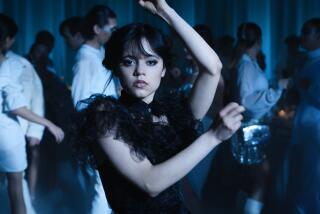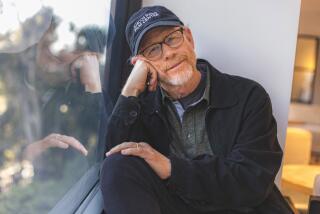‘Bunnytown’ mixes learning, laughs
- Share via
BOREHAMWOOD, England -- Dressed in his red cape and carrot-logo T-shirt, “Bunnytown’s” Super Bunny soars skyward above his brightly colored homeland.
“Li’l Bad Bunny’s fast, but he’s forgotten one thing: I can fly faster!” he exclaims.
Yet Super Bunny’s rapid ascent didn’t quite coordinate with a camera movement, so his flying feat needed to be performed again and again, until everyone on the set at Elstree Studios in this London suburb was satisfied.
Super Bunny and his nemesis Li’l Bad Bunny are puppet stars of Playhouse Disney’s new preschool series “Bunnytown,” airing Saturdays and Sundays on the Disney Channel.
The 8-inch-tall rabbits are constructed of foam rubber, covered with fake fur, and have bendy ears, noses resembling blue pingpong balls -- and few teeth. They come in a wide range of colors but are structured basically the same.
Their individuality is defined by clothes, hairdos, accessories and the skills of the American and British puppeteers who activate them and give them voice in an international range of accents.
Standing beneath the wooden platform that displays the elaborate Bunnytown metropolis and farmland, a puppeteer manipulates a bunny on the end of a long pole with a few simple controls that move the creature’s mouth and head.
These rod puppets are the creation of David Rudman, who for more than 20 years worked for Jim Henson productions and was Emmy-nominated for his handling of Cookie Monster and Baby Bear on “Sesame Street.”
“It just started with a design -- it just was a funny drawing that just needed to become a puppet,” says Rudman, who collaborated on the concept with his writer brother Adam, and musical director and composer Todd Hannert.
Martin Baker and Pete Coogan (also alumni of numerous Jim Henson productions, including “The Muppet Christmas Carol”) co-produce the series with Disney, which distributes the show internationally to 72 countries.
“It has a fun irreverence to it, and I guess we best describe the show as a little variety show for preschoolers. It is really driven by music and comedy,” says Baker. “One hopes that the underlying theme is to educate, but it’s not rubber-stamped in a way that a lot of shows are. I think the first job is to entertain.”
Baker and the others acknowledge the impact the late Jim Henson -- the man who gave the world Kermit the Frog -- had on their imaginations and sensibilities.
“Jim loved silliness,” Baker says, chuckling.
“Yes, silly was good. Silly is good,” Coogan says with a laugh.
“Collaboration too,” adds Rudman. “He [Henson] was big on collaboration, and that’s what we have on this show. Everyone is open to throw out ideas.”
Each half-hour episode consists of 10 to 12 segments of giggly bunny adventures, linked by a running gag and crammed with all styles of music, including The Bunnytown Hop.
Each episode also features a couple of stylized live-action segments. However, unlike “The Muppet Show,” puppets and real people don’t mingle in “Bunnytown.” That is why the bunnies don’t have to be anywhere near people size.
“We could do pretty elaborate sets because everything is so tiny. So we could have a big fishing lake. We could have a giant mountain they are climbing. They drive around in cars and airplanes,” says Rudman.
More to Read
The complete guide to home viewing
Get Screen Gab for everything about the TV shows and streaming movies everyone’s talking about.
You may occasionally receive promotional content from the Los Angeles Times.






